COBS News archive
The Comet Observation Database - Structure and content (EPSC 2018-632, Berlin 2018)
September 10, 2018
The Comet Observation Database (COBS) [1, 2] is a unique web service that enables comet observers to submit, display and analyse comet data in a single location. The service currently represents one of the largest databases of comet observations (containing more than 235,000 observations) and is available to comet observers worldwide.
The Comet Observation Database - Observer tools and case study (EPSC2018-644, Berlin 2018)
September 10, 2018
Green comet makes closest approach to earth
September 09, 2018
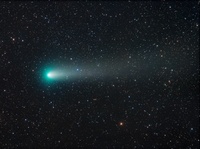
On Sept. 10th, Comet 21P/Giacobini-Zinner ("21P" for short) will make its closest approach to Earth in 72 years--only 58 million km from our planet. This small but active comet is easy to see in small telescopes and binoculars as it shines like a 7th magnitude star. Michael Jäger of Weißenkirchen, Austria, sends this photo of 21P passing through the stars of Auriga on Sept. 7th.
A Green Comet Approaches Earth
August 25, 2018
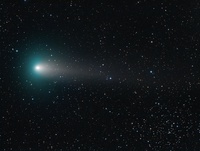
The cautionary tail of Comet Swift–Tuttle
August 10, 2018
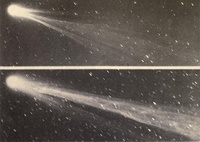
New Comet: C/2018 N2 (ASASSN)
July 18, 2018
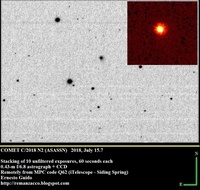
MPEC 2018-O01, issued on 2018, July 16, announces the discovery of a comet (magnitude ~16.1) in the course of the "All-Sky Automated Survey for Supernovae" (ASASSN) program, in images taken 2018 July 7-11 with the 14-cm "Cassius" survey telescope at Cerro Tololo. The new comet has been designated C/2018 N2 (ASASSN).
Molecular oxygen in comet's atmosphere not created on its surface
July 09, 2018
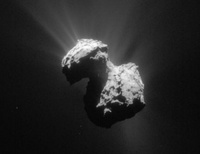
Chasing 'Oumuamua
June 29, 2018
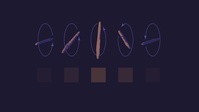
Our Solar System's First Known Interstellar Object Gets Unexpected Speed Boost
June 29, 2018
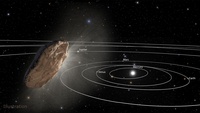
Using observations from NASA's Hubble Space Telescope and ground-based observatories, an international team of scientists has confirmed 'Oumuamua (oh-MOO-ah-MOO-ah), the first known interstellar object to travel through our solar system, got an unexpected boost in speed and shift in trajectory as it passed through the inner solar system last year.
`Oumuamua gets a boost
June 29, 2018
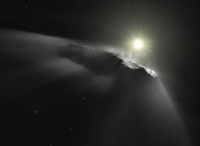
Interstellar asteroid is really a comet
June 29, 2018

Rosetta image archive complete
June 22, 2018

What interstellar visitor 'Oumuamua can teach us
March 28, 2018
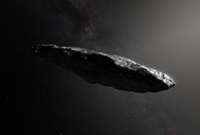
The first interstellar object ever seen in our solar system, named 'Oumuamua, is giving scientists a fresh perspective on the development of planetary systems. A new study by a team including astrophysicists at NASA's Goddard Space Flight Center in Greenbelt, Maryland, calculated how this visitor from outside our solar system fits into what we know about how planets, asteroids and comets form.
A star disturbed the comets of the solar system 70,000 years ago
March 21, 2018
About 70,000 years ago, a small reddish star approached our solar system and gravitationally disturbed comets and asteroids. Astronomers from the Complutense University of Madrid and the University of Cambridge have verified that the movement of some of these objects is still marked by that stellar encounter.
New Comet: C/2018 E1 (ATLAS)
March 20, 2018

CBET nr. 4494, issued on 2018, March 16, announces the discovery of an apparently asteroidal object (magnitude ~17) in the course of the "Asteroid Terrestrial-impact Last Alert System" (ATLAS) search program on CCD images obtained with a 0.5-m f/2 Schmidt reflector at Haleakala, Hawaii. Posted on the Minor Planet Center's PCCP webpage, it has been reported as showing cometary activity by CCD astrometrists elsewhere. The new comet has been designated C/2018 E1 (ATLAS).
Interstellar asteroid, 'Oumuamua, likely came from a binary star system
March 20, 2018
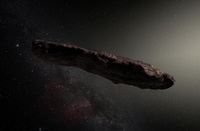
Comet 'Chury's' late birth
March 19, 2018
Comets which consist of two parts, like Chury, can form after a catastrophic collision of larger bodies. Such collisions may have taken place in a later phase of our solar system, which suggests that Chury can be much younger than previously assumed. This is shown through computer simulations by an international research group with the participation of the University of Bern.
Rosetta and Planck honoured in annual Royal Astronomical Society awards
January 15, 2018
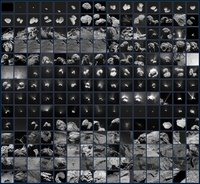
NASA's newly renamed Swift Mission spies a comet slowdown
January 11, 2018
Arecibo Radar Returns with Asteroid Phaethon Images
January 08, 2018
